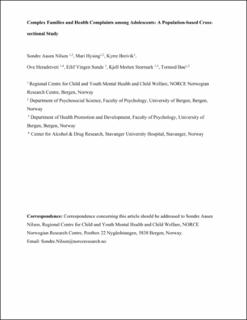| dc.description.abstract | Aims: The structure of adolescents’ families has become more complex over the last decades in several western countries. In parallel, health complaints among adolescents appear to have risen in the Nordic countries. This study aimed to examine the association between family structure and health complaints among Norwegian adolescents while capturing biological, half-, and stepsiblings (sibship-type) in the families. Methods: Data stem from the youth@hordaland study, an epidemiological study of adolescents aged 16–19 years (N = 10,257; participation rate = 53%) conducted in 2012. This study is based on a subsample of 8808 adolescents who lived with parent(s). The adolescents provided detailed information on sociodemographics, family structure, sibship-type, and common health complaints among youth (headache, dizziness, and abdominal, neck, back, and shoulder pain). Results: Adolescents in nuclear families and joint physical custody (JPC) reported significantly lower levels of health complaints compared to peers in single- or stepparent families. Independent of family structure, biological siblings were associated with lower levels of health complaints, while stepsiblings were associated with higher levels of health complaints, but only among girls. These findings were robust to adjustments of sociodemographic variables. Conclusions: Health complaints are frequent but unequally distributed across family structures. Adolescents in nuclear families and JPC report lower levels of health complaints compared to peers in single- or stepparent families. Considering siblings appears to be relevant, as biological- and stepsiblings were related to adolescents’ symptoms, independent of family structure. In combination, knowledge about family structure and sibship-type may aid the identification of adolescents at risk of experiencing health complaints. | |
